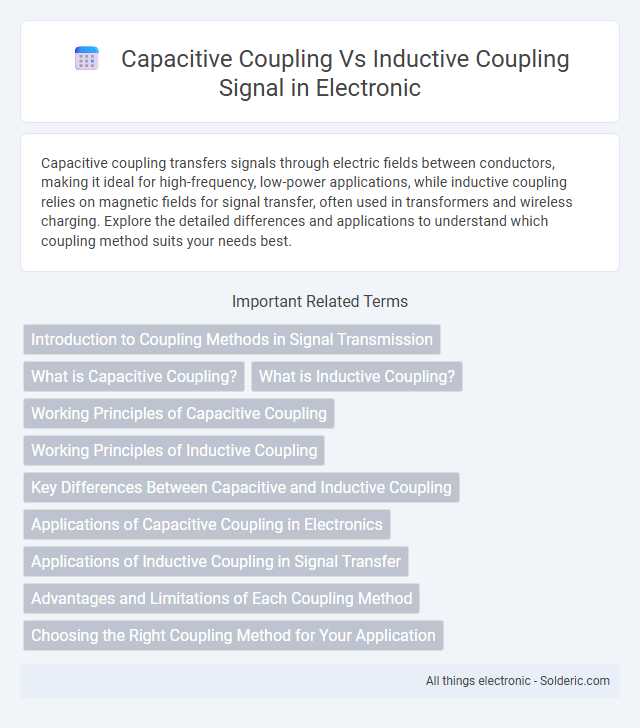Capacitive coupling transfers signals through electric fields between conductors, making it ideal for high-frequency, low-power applications, while inductive coupling relies on magnetic fields for signal transfer, often used in transformers and wireless charging. Explore the detailed differences and applications to understand which coupling method suits your needs best.
Comparison Table
| Aspect | Capacitive Coupling | Inductive Coupling |
|---|---|---|
| Principle | Transfer of signal via electric field between two conductors. | Transfer of signal via magnetic field inducing current in a coil. |
| Frequency Range | High-frequency signals (typically > 1 kHz). | Wide frequency range, effective at low to medium frequencies. |
| Coupling Medium | Electric field across a dielectric. | Magnetic field around coils or inductors. |
| Signal Transfer | Capacitor formed between plates couples the signal. | Magnetic flux induces voltage in secondary coil. |
| Applications | High-speed digital circuits, signal isolation, touchscreens. | Wireless power transfer, transformers, RFID, metal detectors. |
| Advantages | Simple, low cost, good for high frequencies. | Efficient power transfer, good penetration through materials. |
| Limitations | Limited to close proximity, sensitive to noise. | Requires coil alignment, limited range for signal. |
Introduction to Coupling Methods in Signal Transmission
Capacitive coupling transfers signals through electric fields between two conductors separated by a dielectric, enabling high-frequency transmission with minimal signal loss. Inductive coupling relies on magnetic fields generated by current flow in a coil, inducing voltage in a nearby coil, ideal for wireless power transfer and low-frequency applications. Both methods are fundamental in signal transmission, with capacitive coupling favored in integrated circuits and inductive coupling commonly used in transformers and RFID systems.
What is Capacitive Coupling?
Capacitive coupling is the transfer of electrical energy between circuits through the electric field generated by the voltage difference across a dielectric medium, such as an insulating material. This form of coupling allows high-frequency signals to pass between components while blocking direct current and low-frequency signals. Capacitive coupling is commonly used in analog circuits, signal processing, and communication systems to isolate stages and prevent DC bias interference.
What is Inductive Coupling?
Inductive coupling is a method of signal transmission that uses magnetic fields to transfer energy between two coils or conductors without direct electrical contact. It operates based on Faraday's law of electromagnetic induction, where a changing current in the primary coil induces a voltage in the secondary coil. This technique is commonly used in wireless power transfer, RFID systems, and transformers to enable efficient and contactless signal or energy transfer.
Working Principles of Capacitive Coupling
Capacitive coupling transmits signals through the electric field created between two conductive plates separated by a dielectric material, allowing AC signals to pass while blocking DC components. The changing voltage across the capacitor induces displacement current, enabling signal transfer without direct electrical connection. This principle makes capacitive coupling effective in isolating stages in amplifiers and filtering unwanted frequency components.
Working Principles of Inductive Coupling
Inductive coupling relies on the principle of magnetic field induction between two coils, where a time-varying current in the primary coil generates a magnetic flux that induces a voltage in the secondary coil. This wireless energy transfer method is commonly used in transformers, RFID systems, and wireless charging applications, providing efficient signal transmission over short distances. Your devices benefit from minimal signal loss and reduced electromagnetic interference when using inductive coupling for communication or power delivery.
Key Differences Between Capacitive and Inductive Coupling
Capacitive coupling transfers signals through electric fields between conductive plates separated by a dielectric, while inductive coupling relies on magnetic fields generated by current in a coil inducing voltage in a nearby coil. Capacitive coupling is typically used for high-frequency applications with low current, offering minimal signal loss over short distances, whereas inductive coupling efficiently transmits power and signals over longer distances with magnetic flux linkage. The primary difference lies in the coupling mechanism--electric field for capacitive and magnetic field for inductive--impacting their efficiency, range, and applicability in circuits and wireless power transfer systems.
Applications of Capacitive Coupling in Electronics
Capacitive coupling is widely used in electronics for signal transmission between circuits while blocking DC components, making it ideal in audio equipment, RF circuits, and amplifiers. Your devices benefit from this method when isolating signal paths to reduce noise and enhance clarity, especially in sensors and touchscreens. This technique enables efficient filtering and impedance matching, crucial for maintaining signal integrity across various electronic applications.
Applications of Inductive Coupling in Signal Transfer
Inductive coupling is widely used in applications such as wireless power transfer, RFID systems, and transformers due to its ability to transfer signals efficiently without direct electrical contact. This method enables data transmission in environments where electrical isolation is crucial, such as in medical implants and industrial sensors. Your devices can benefit from inductive coupling by ensuring reliable communication in harsh or constrained spaces where capacitive coupling may be less effective.
Advantages and Limitations of Each Coupling Method
Capacitive coupling offers advantages such as high-frequency signal transmission with minimal energy loss and simple implementation in integrated circuits, but it is limited by sensitivity to parasitic capacitances and reduced effectiveness at low frequencies. Inductive coupling excels in transferring signals over isolated or separated conductive paths, providing galvanic isolation and robustness against electrical noise, yet it struggles with low-frequency efficiency and requires larger components for effective coupling. Your choice depends on the specific application requirements, balancing the need for frequency range, isolation, and size constraints.
Choosing the Right Coupling Method for Your Application
Choosing the right coupling method for your application depends on factors like signal frequency, distance, and power requirements. Capacitive coupling excels at high-frequency signal transfer with minimal power loss, making it ideal for short-range communication and sensor interfaces. Inductive coupling suits applications needing wireless power transfer or longer-range signal transmission, commonly used in RFID systems and wireless chargers.
Capacitive coupling vs inductive coupling signal Infographic

 solderic.com
solderic.com